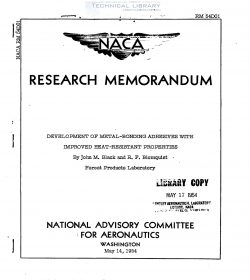naca-rm-54d01
- Version
- 54 Downloads
- 601.42 KB File Size
- 1 File Count
- August 13, 2017 Create Date
- August 13, 2017 Last Updated
National Advisory Committee for Aeronautics, Research Memorandum - Development of Metal Bonding Adhesives with Improved Heat Resistant Properties

Results are reported of current studies at the Farest Products
Laboratory to develop a metalébonding adhesive with greater resistance
to temperatures up to 6000 F that is easier to use than present ones.
Most promising is a formulation of phenol and epoxy resins modified with
hexamethylenetetramine and supplied for use as a dry tape supported on a
glass—mat base.
The present paper is a report on the development of metalAbonding
adhesives with improved heat-resistant properties undertaken at the
Forest Products Laboratory under the sponsorship and with the financial
assistance of the National Advisory Committee for Aeronautics. The work
described in this report is a continuation of the work on adhesive formu-
lations based on phenol resins and epoxy resins reported in reference 1.
In reference 1 an adhesive designated as FPL—Tlo was described that
developed promising shear strength when tested at elevated temperatures
up to 6000 F and also possessed good resistance to aging at temperatures
as high as #500 F. The principal limitations of adhesive FPL—Tlo were
that it was somewhat brittle, it possessed marginal bend and fatigue
strength and variable performance at 6000 F, and the optimum film.thick—
ness for bonding (0.002 inch) was too thin for practical use in aircraft.
The objectives of the investigation were to improve the performance
of adhesive FPL—TlO at #500 to 6000 F and still maintain adequate shear
strength at -70° F, to reduce brittleness, and to improve resistance to
bending, peel, and fatigue. It was also planned to investigate the per—
formance of EFL-710 and subsequent improved formulations for the bonding
of stainless steel and titanium and to investigate their possible use as
lendnating resins for glass fabrics for service at high temperature. In
addition, work was to be undertaken to make these adhesives as simple as
possible to use in the production of bonded parts.
The preparation and recommended application and bonding procedure
for FPL—710 adhesive were reported in reference 1. The present investi-
gation has resulted in one change in formulation, namely, in the amount
of hexamethylenetetramine (hexa) included. The presently recommended
formulation for the adhesive is 4 grams of hexa (instead of 6 grams),m
100 grams of Bakelite BV 9700, and 20 grams of Epon resin 1007 dissolved
in methyl ethyl ketone. The recommended cure of the adhesive has also
been changed to 30 minutes at 520° F instead of 60 minutes at 2800 F.
| File | Action |
|---|---|
| naca-rm-54d01 Development of Metal Bonding Adhesives with Improved Heat Resistant Properties.pdf | Download |

Comment On This Post